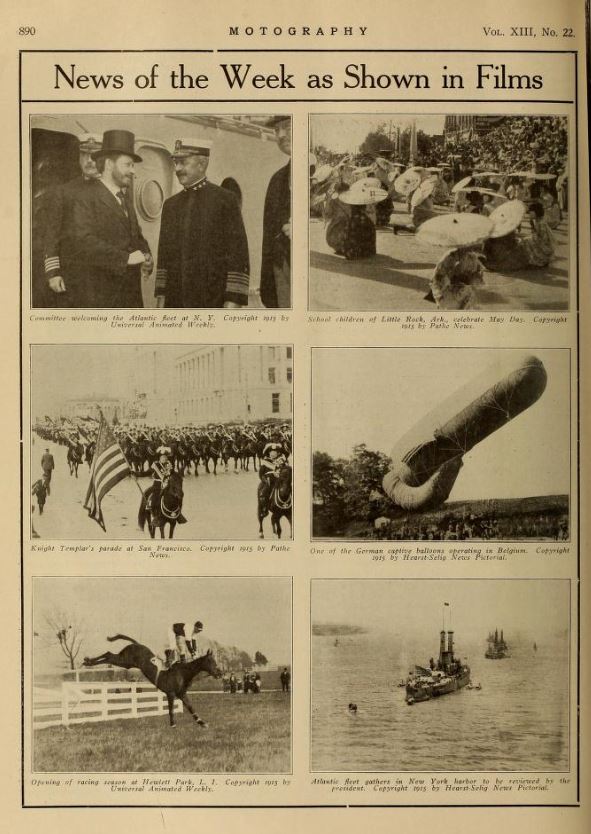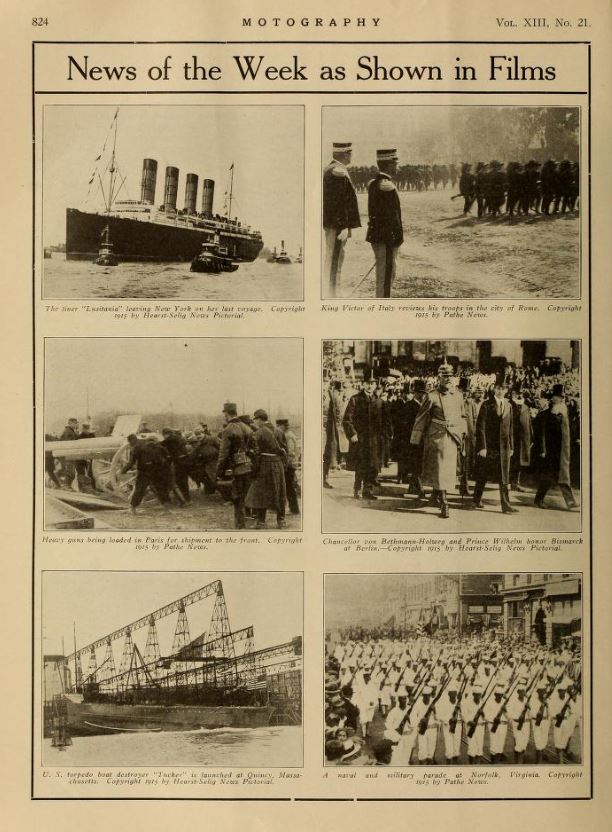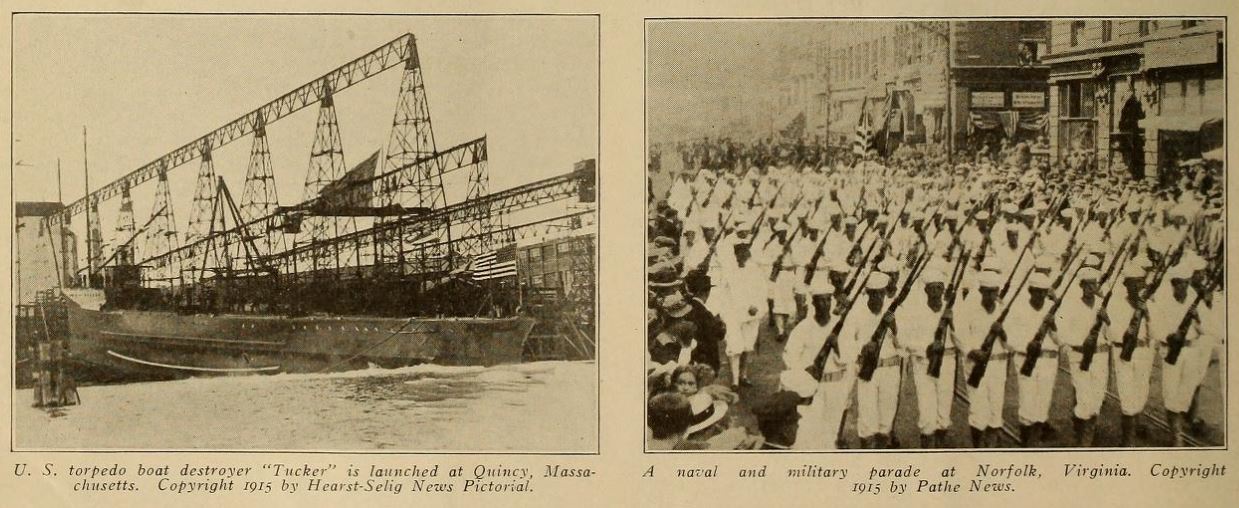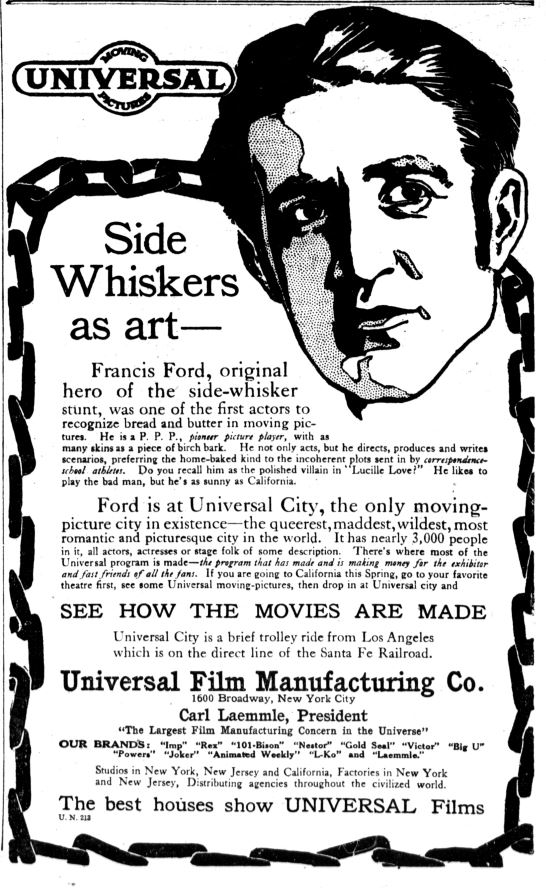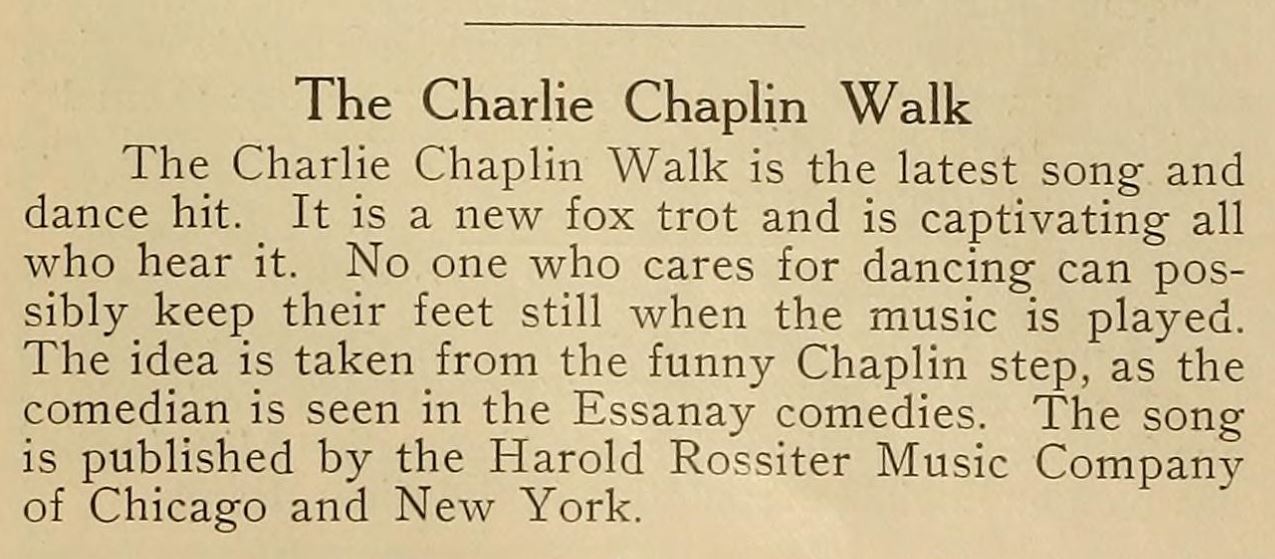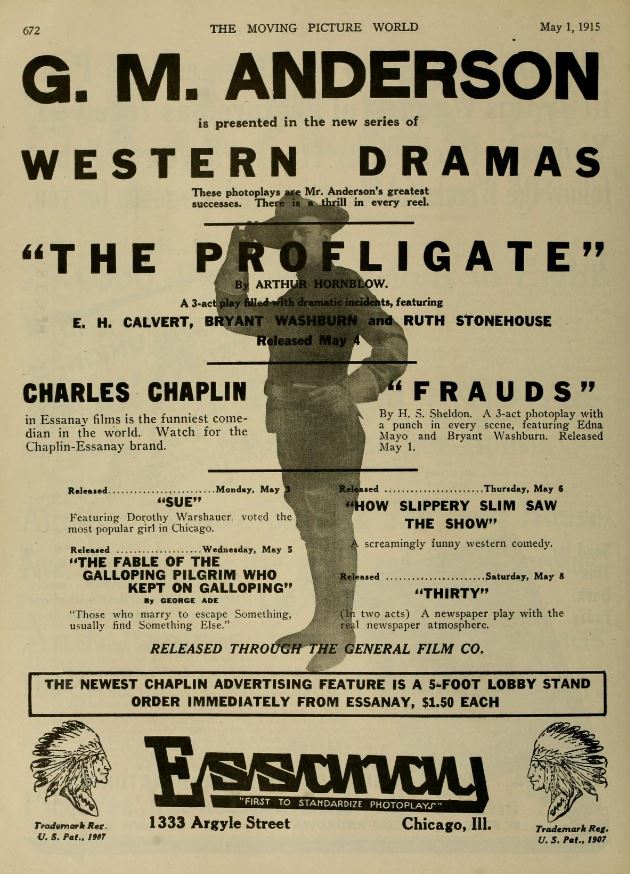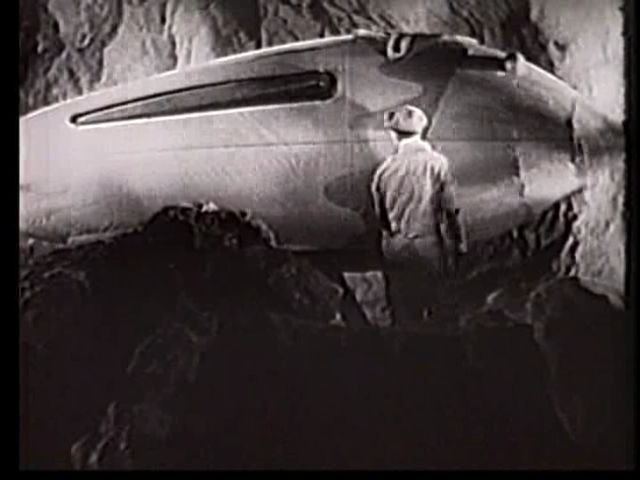This post is part of For the Love of Film IV, The Film Preservation Blogathon, hosted by Ferdy on Films (http://www.ferdyonfilms.com/ -- Wednesday, Thursday), This Island Rod (http://thisislandrod.blogspot.com/ -- Friday, Saturday) and Wonders in the Dark (https://wondersinthedark.wordpress.com/-- Sunday). The theme this time is science fiction, and the organizers hope to raise $10,000 to restore and stream a 1918 one-reel comedy, "Cupid in Quarantine."
Be sure to click on images to see larger versions.
 |
| Cine-Mundial, February, 1921 |
Tom Mix was the biggest cowboy star in silent movies. In fact, he was one of the biggest stars of all. He told many stories about his early life and most of them were not true. His name really was Tom Mix. He was not born in the west; he was born in Mix Run, Pennsylvania. He did serve in the US Army during the period of the Spanish American War, but he was not one of Theodore Roosevelt's Rough Riders and he did not serve overseas. He did not serve in the British Army or Boer army or break horses during the Boer War. He did not serve during the Boxer Rebellion. He was not a federal marshal, although he was a deputy sheriff for a time. He was not a Texas Ranger until a governor gave him an honorary appointment during the 1930s. He did serve as a cowboy on the Miller Brothers' 101 Ranch and became part of their travelling wild west show. Mix displayed wonderful talents for riding and shooting. He was also a great showman.
 |
| Lincoln County Leader, 04-December-1914 |
In October, 1909, Tom Mix left the Miller Brothers to join the Selig Polyscope Company to make western movies. First he played supporting parts and did stunts, but in a few years he was writing, directing and starring in movies, like "Way of the Red Man." Selig made some westerns in Arizona.
 |
| Saint Johns Herald and Apache News, 23-October-1914 |
In 1914, Tom Mix, "famous fancy rider and bulldogger," presented "the best program of Western stunts, flat and harness racing, and automobile and motorcycle races ever pulled off in Northern Arizona..." at the First Northern Arizona Fair in Prescott. Tom had won rodeo events at Prescott in 1909. "The Selig Polyscope Company stars will present BIG VAUDEVILLE PROGRAM at Elks' Theater..."
Many of his Selig films, which were short subjects and often rather primitive, still survive. Some were later reedited into features and serials.
 |
| Film Daily, 05-October-1926 |
In 1917, Mix left Selig and went to the Fox Film Corporation. Mix made features for Fox, and the well-budgeted films became very popular. There was always lots of action, lots of humor and Tony the Wonder Horse. Most of his Fox films were destroyed in a 1937 film vault fire.
The Great K&A Train Robbery is one of the small number that survives. It is a good one. Notice Mix sliding across a canyon on a wire.
 |
| Film Daily, 07-May-1928 |
By 1928, Fox had become involved with Movietone sound films and was less interested in westerns, which would have been difficult to make with sound. Mix went to FBO (Film Booking Office) to do a series of silent westerns ("Tom Mix Western Super Specials") produced by Joseph P Kennedy (Father of John F Kennedy and the rest). These movies were successful, but his contract was not renewed after the first year. Westerns were losing their popularity and Mix commanded a large salary.
 |
| Moving Pictures Daily, 26-June-1931 |
Mix left the movies for a while but ran into the Great Depression and legal difficulties, and was happy to listen when Universal offered to star him in a series of six sound features ("Six Mix Pix"). The movies were so popular that Universal produced nine.
Mickey Rooney, who died in 2014, must have been Mix's last surviving costar.
Mix's voice was ok. He was not a trained actor, so his delivery was nothing special.
Universal wanted him back, but Mix had had enough and announced his retirement at the end of the series. Mix travelled with circuses for a few years, eventually buying one, and running into money trouble with it.
In 1935, Nat Levine of Mascot Studio paid Mix $40,000 to work for four weeks. This was half the budget of The Miracle Rider, a 15 chapter serial. Mix needed the money to subsidize his circus. This turned out to be his last movie. I was surprised to learn that it was Mascot's only 15 chapter serial. I had thought that 15 was the standard length after producers settled on a standard and before they went to 12 as a cheaper standard.
Nat Levine founded the Mascot Pictures Corporation in 1927. Mascot produced mostly serials and what later became known as B westerns. Mascot produced the first sound serial, King of the Kongo, in 1929. In 1935, Mascot merged with other producers and Herbert Yates' Consolidated Film Industries to form Republic Pictures.
The first episode of The Miracle Rider, "The Vanishing Indian," was almost feature length. It used an animated map to show "Indian Territory" shrinking and the United States growing over the years. Some of the dates on the map were questionable. Scenes showed Daniel Boone, then Davy Crockett, then Buffalo Bill Cody, then Sam Morgan trying to get European Americans to stop intruding on the territory of Native Americans. Who was Sam Morgan? He was the father of Tom Morgan, Tom Mix's character.
Sam Morgan was trying to defend the reservation of the Ravenhead tribe when he was murdered by a group of men who wanted to squat on their land. Young Tom promises to join the Texas Rangers and carry on his father's work. Twenty years later, Tom has aged considerably. His hair is dyed black and his teeth are false, but he is still a heroic figure. Note the white teeth in this image.
I only noticed one scene where Mix performed with his old mugging humor, when he stopped two kids from stealing a pie and then tried to steal it himself.
The Ravenhead have pooled their money to buy farm equipment. A group of white men hijack the auto with the money but Tom gets it back. The Ravenhead regard Tom as a brother and give him the name Ho-Pan, "The Miracle Rider." After the ceremony, Zaroff congratulates Tom. The Chief and the Indian Agent look dubious.
Zaroff is played by Charles Middleton, about whom I still have bad dreams from Flash Gordon and Laurel and Hardy movies. Zaroff has a ranch and an oil company, but he is secretly mining X-94, a super explosive, from the Ravenhead reservation. Later in the movie, Zaroff's scientist discovers a way to turn X-94 into a powerful fuel that can replace gasoline. Image if a Native American tribe controlled all of this country's energy supplies.
Zaroff wants to scare the Ravenhead off the reservation so he can mine the X-94 more easily.
I lost count of how many times Zaroff said he was going to be "the most powerful man in the world."
Niles Welch played the scientist, Metzger, in a suitably creepy fashion. He had a long career in silent and sound films, but I don't remember him in anything else.
Zaroff's first attempt to scare the tribe away used a large mirror on a tower to set things on fire around the village. The tribe members said it was the work of the "Fire Bird." Actually, it was the work of Metzger. Long Boat tells people the Ravenhead are cursed and must leave the land. Chief Black Wing argues with him.
Jason Robards, Sr, who sounded a lot like his famous son, played Zaroff's chief henchman, Carlton.
Zaroff shows Carlton a model of Metzger's next project, a "rocket powered glider" controlled by radio. It flies from a cave and buzzes the village at night, causing more panic about the Fire Bird. I was sad to see the open cockpit monoplane Fire Bird crash in chapter 2. The wreckage got stolen back and forth a few times.
One of Zaroff's lesser henchmen was played by Tom London, who may have appeared in more movies than anyone else, from the mid-Teens to the early 1960s. Another was Charles "Blackie" King, who was always worth watching.
A "rocket powered glider" in a western may sound strange, but many westerns made in the 1930s and 1940s were set in contemporary times and often featured automobiles and airplanes. Here we see two members of the tribe arrive at the Indian Agent's office in a touring car. Some movies, such as Mascot's previous serial, The Phantom Empire with Gene Autrey, had strong elements of science fiction.
Some of the cliffhangers were different compared to what later became standard in Republic, Columbia and Universal serials. In one, the chapter ends with a bunch of cowboys holding their guns on Tom. There are no shots fired. In the next chapter, Tom's horse, Tony Jr, blows a car horn and allows Tom to escape. There are some very clear cheaters, chapters ending with Tom falling to his doom or getting shot. The next chapters begin differently.
Tom Mix was still a convincing hero. I didn't care that he had trouble with his lines. He sounded like a real person.
I enjoyed the credits and introduction for each episode. There was a stirring classical theme, whose name I don't know. Someone will tell me. There was a tracking shot of Tom and Tony Jr riding hell for leather, followed by a tracking shot along a rocky hillside that underlay most of the credits. Underneath the cast of characters, there was a Native American crouching, then standing and scanning the horizon, then invoking the gods, then squatting, then standing.
The general treatment of Native Americans? So-so. Bob Kortman, whom I loved in Laurel and Hardy movies, played Long Boat, who wanted to be chief. He worked secretly for Zaroff. Tom Morgan was his great rival. I liked the way Long Boat kept calling Tom "My brother" with a great sneer. Zaroff knew the terrible secret that Long Boat was a "half breed."
I liked the wireless (I think) telephones Zaroff used to communicate with Long Boat and his cowboy henchmen. This one was hidden in a rock cairn.
Zaroff used what looked like a text terminal to communicate wirelessly with a buyer in Europe.
The Miracle Rider was directed by B Reeves Eason and Armand Schaefer. Many serials were directed by teams because of the amount of footage that had to be shot. Breezy Eason directed a lot of movies, mostly action films, between 1915 and 1949. He directed many serials including The Phantom Empire and Mystery Mountain. He also staged action scenes for major productions like the silent Ben Hur and Charge of the Light Brigade. Schaefer worked on many Mascot serials.
According to The Old Corral (
http://www.b-westerns.com),
The Miracle Rider, which had cost $80,000 to produce, twice as much as most Mascot serials, was Nat Levine's most profitable. Theaters paid $15 dollars to rent chapter one, and $5 for each of the others, for a total of $85.
 |
| Film Daily, 11-August-1948 |
When television spread after the war, serials like The Miracle Rider generated money again.
I first saw this serial on KEMO-Channel 20's The Old Sourdough and Wachikanoka or The Worst of Hollywood. I managed to stay awake late enough each Friday night to see all 15 chapters.
I had read William K Everson and George Fenin's disparaging comments on the movie:
"But unfortunately Mix chose to make his farewell in a 1935 serial for Mascot, The Miracle Rider. Overlong, slimly plotted, and cheaply made, it was a sorry affair. Mix's speech had deteriorated further and, while he still rode well, most of his action was handled by doubles. (This was at least partially a matter of economy, allowing two units to operate simultaneously.)"
-- George N Fenin and William K Everson, The Western from Silents to Cinerama, 1962.
I enjoyed the book, which I took out from the Anza Branch Library several times, but I didn't agree with them about the movie when I got to see it.
Why does this film survive? Mascot serials have an excellent rate of survival because many of them fell into the public domain and got copied and recopied, especially when home video got started.
Tom Mix went back on the road with the Tom Mix Circus, which did well in the 1935-1937 seasons, but went bankrupt in 1938.
On 12-October-1940, Mix was driving his powerful 1937 Cord 812 automobile from Tuscon to Phoenix. Near the town of Florence, Arizona, he encountered some road construction and lost control. An aluminum suitcase hit him in the back of the head and killed him. I have visited the memorial at the place where he died. The car survived and has been restored (
http://tommixcord.com).
Tom Mix may have died in 1940, but he lived on in other media. In 1933, Ralston Purina signed Tom Mix to a contract to use his name and his character for a radio show, The Tom Mix Ralston Straight Shooters. Various actors played "Tom Mix" on the program until 1950. The show was famous for the premiums it offered to listeners who sent in box tops.
A compass and magnifier premium from 1939. Note the logo from Tom's TM Bar Ranch.
Fawcett Comics published
Tom Mix Western from 1948 to 1953. Many covers featured a colorized photo of Mix, who had been dead for almost eight years when the comic began. The January, 1948 issue offers "Two-Fisted Adventures and Thrills! Starring the Greatest Cowboy of the Golden West!"
Peter Blake and Jann Haworth designed the album cover for the Beatles' Sgt Pepper's Lonely Hearts Club Band, inspired by a drawing by Paul McCartney. Among the celebrities in the collage is Tom Mix. Look for the big white hat.
Thank you to Ferdy on Films (http://www.ferdyonfilms.com/), This Island Rod (http://thisislandrod.blogspot.com/ ) and Wonders in the Dark (https://wondersinthedark.wordpress.com/) for organizing this blogathon. I am having fun and learning. Thank you to everyone who visited and I encourage you to read as many posts as you can, and leave comments. Bloggers love comments.
Please consider donating to the National Film Preservation Foundation. For the Love of Film IV is raising money to restore "Cupid in Quarantine" (1918), a one-reel Strand Comedy that tells the story of a young couple conspiring to stay together by staging a smallpox outbreak. No kidding.










